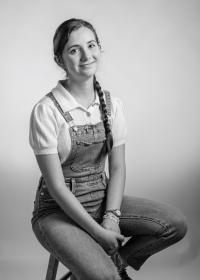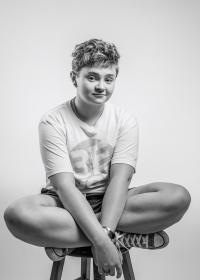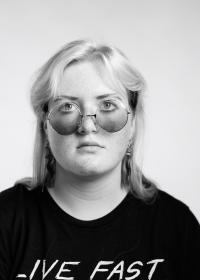
Read Time: 5 minutes
Professional conventions can be useful, maybe even enjoyable, once in a while. But for Terisa Gabrielsen, a convention of the National Association of School Psychologists (NASP) a few years ago lit a spark of inspiration that became a groundbreaking book on the unique characteristics of female autism.
“It started with colleagues sitting around a table with common interests: students from underserved populations, students from ethnic minorities, students with economic disadvantages, and girls,” says Gabrielsen, an associate professor of school psychology in the McKay School. The initial meeting turned into NASP presentations the following year. “And it just kept coming up: ‘Are you going to talk about girls? Are you going to talk about girls?’”
Intrigued, Gabrielsen says, she looked into existing literature on females and autism—an area that was already one of her research interests.
“At the time I was proposing this book, nothing like it existed, to my knowledge,” she says. “There’s a lot out there, but there’s no guidebook, compilation, or handbook that pulls it together, especially when it comes to updating assessment practice.”
The new book, Assessment of Autism in Females and Nuanced Presentations: Integrating Research into Practice, outlines autism characteristics in women and girls but also integrates existing research and first-person accounts into what is essentially a manual describing the nuanced ways that females have been systematically excluded from autism identification over the years.
Besides Gabrielsen, the authors are K. Kawena Begay of the University of Washington, Tacoma; Kathleen Campbell, a pediatrician at the Children’s Hospital of Philadelphia; Katrina Hahn, a speech and language pathologist at the University of Utah Developmental Assessment Clinic; and Lucas Harrington, a licensed clinical psychologist at the University of Washington Autism Center, who is autistic.
The book contract was signed in mid-2020, Gabrielsen says, and “that was very fortunate because between 2020 and 2022, the research on women and autism exploded, and we were able to get all of that in the book. It’s a research-to-practice manual, which is so important for evidence-based practice. It’s for clinicians, but it’s also got a healthy proportion of first-person narrative and new research to make it accessible.”
The first-person element—drawn from almost 1,400 stories, perspectives, and personal observations—is vital, Gabrielsen says, because women have been excluded from research on autism for decades, with their unique needs and characteristics under diagnosed, dismissed, or ignored. “These women are telling us, ‘I just need someone to listen to me,’” she says.
“Autistic women have higher suicidal thoughts and behaviors than any other group besides neurotypical men. That’s a huge number, and it still only counts the women who we know are autistic.
“These women have suffered so much their whole lives, and that’s not an exaggeration. They’ve been asking, ‘Please help me,’ and they are told, ‘You have anxiety, you have depression, and you have this and that.’ There’s this trail of diagnoses—incomplete diagnoses, or misdiagnoses—that are so typical. If we can accurately diagnose them earlier, we have a shot at alleviating that suffering because we know more about how their brains work.”
The first step is understanding that—like heart disease, stroke, osteoporosis, and a host of other conditions—autism presents differently in females than in males, Gabrielsen says.
Those differences have complex origins. For one thing, females are more likely to “mask” or suppress parts of their autistic identity in social settings. This can lead to behavioral problems at home, where they are exhausted from hiding who they really are all day and need to drop the mask at home to recover. These meltdowns might be written off as female “hysteria” or
“drama” in girls.
Gendered social expectations can also mean that girls who sit alone, play quietly, read constantly, or fixate obsessively on an interest—signs often noted in autistic males—aren’t seen as worryingly atypical, even though those behaviors might be coping mechanisms for autism.
“It starts to escalate in adolescence when they are left behind socially and victimized,” Gabrielsen says. “There are a lot of things about their experience that are dismissed. Being dismissed is the hardest part, because they know something is going on, they seek help, and yet they are told, ‘You seem fine; go home.’”
Gabrielsen says women and girls are, as a group, socialized from a young age to notice and adapt to behaviors in others, and that includes autistic females.
“A girl with autism will watch other people,” she says. “She is working her guts out trying to figure out what she’s not doing right that’s getting her excluded, bullied, and made fun of. In friendships, everyone is trying to figure out what everyone else is thinking, but it takes these girls ten times longer to figure that out. A girl with autism will flit from group to group: she’s trying to figure out how to get into the play, and she can’t, and no one’s helping her.”
This problem is compounded by autism diagnostic tools such as the widely used Autism Diagnostic Observation Schedule (ADOS), Gabrielsen adds. Studies have shown that ADOS is more likely to miss autism in females and that this happens not because girls present fewer restricted interests and repetitive behaviors but because the test simply misses some of the behaviors researchers now know to look for in girls (see Nicholette Zeliadt, “Diagnostic Tests Miss Autism Features in Girls,” News, Spectrum, 13 May 2017, spectrumnews.org/news/diagnostic-tests-miss-autism-features-girls).
Gabrielsen said that’s not surprising, considering the fact that when ADOS was created, there were “hardly any women” in test makers’ sample groups. This lack of representation is compounded by the aforementioned female masking skills.
“The camouflaging can be so automatic for them that it is hard to turn off,” Gabrielsen says. “But as soon as the ADOS is over, the performance is over, and we begin to see the real person.”
The book includes discussions of women’s lives from birth through menopause, Gabrielsen says, because autistic females often spend their lives undiagnosed, bewildered about why they don’t “fit in,” and struggling to navigate social interactions. “They may have sensory issues all their lives, and that’s a quality-of-life issue,” Gabrielsen says. “It interferes with what you can and cannot do and where you can and cannot go. It affects everything. Add in lack of ability to read social cues accurately, and this person faces rejection constantly.”
This cascade of traits and (missed) diagnoses is sadly common in women and girls with autism—but it doesn’t have to be. Increasing awareness of what autistic traits may look like in females, as the book Assessment of Autism in Females describes, can be a life-changing first step.
“We’re not saying that we have to change everything about how we do things; we’re just suggesting we shift our approach,” Gabrielsen says. “In addition to girls and women, this could also potentially help more cisgender males or the many transgender kids who have autism.”
In the end, Gabrielsen says, she and her coauthors want to see a more equitable world for females with autism—one in which they are diagnosed young, treated effectively, and given the support and respect every person deserves.
“Our goal is to remove the barrier that has the women on one side and the clinicians on the other side,” she says. “We want to get that wall down so that the clinicians will listen to the women and give them the support they need to be themselves.
Cielo Bake

Hometown: Mesa, Arizona
Major: Interdisciplinary humanities, English emphasis
Interests: I adore playing the piano, writing and singing music, reading absolutely anything with words on it, making art, and ballroom dancing!
Age at Diagnosis: 20
One thing you wish more people knew about living with autism:
Every day is a battle for me! Also, there needs to be more research on how to improve the autistic living experience instead of trying to find a cure—there is nothing to be cured! We need to think of people as different ecosystems instead of machines to be run—seeing our differences not as malfunctions but as unique and valid ways of experiencing the world.
Avery Empey

Hometown: South Jordan, Utah
Major: Animation
Interests: The X-Files, rainy days, geology, psychology, Star Trek, swimming, autumn weather, writing stories
Age at Diagnosis: 17
One thing you wish more people knew about living with autism:
Most of the time I’m trying really hard to be convenient and palatable to people, and it would be great if more people met me in the middle with acceptance rather than expecting all the social/emotional labor of acceptability to be on my shoulders.
K. Ryann Allen

Hometown: West Jordan, Utah
Major: Media arts pre-major
Age at autism diagnosis: 19
Interests: Candid photography/videography and art (crafts, cross-stitching, drawing) provide a sort of control for me as well as an archive. I don’t tend to stay on one medium too long. I’ll research practically anything, but internet history and its branch-offs are my most long-standing topic, along with communities surrounding alternative genres of music and media. They feed my logical need for sense and problem solving and my emotional need for people I can understand.
One thing you wish more people knew about living with autism:
Autism is not an intellectual disability; it’s very much a social difference. If I am given instructions how to do something, I will do it as instructed. I will often ask (or want to ask) for more instructions. I was considered gifted throughout school, but that changed when communication and processing started to fail me. Accommodations and additional resources go far for people like me. Also, it’s time-consuming to communicate because I always want to describe things very particularly. Communication and processing times are my biggest roadblocks. It’s a constant game of studying, guessing, making shots in the dark, and trying to be less afraid of imperfection—embracing it even. Forgiving myself for perceived shortcomings has been a long road and will continue to be.
Written by Stacey Krantz
Photography by Bradley Slade